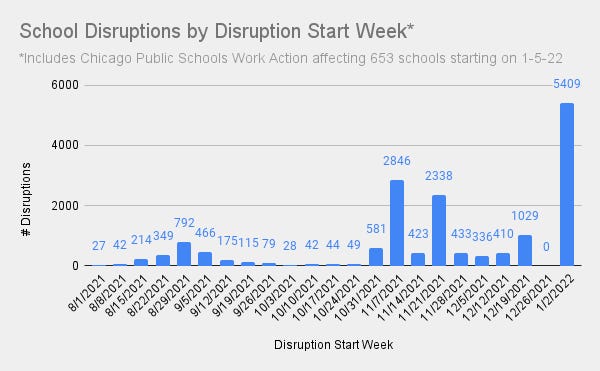My husband and I typically debrief one another on the news over dinner each night. We’ve been following the rise in Portland gun violence for the last year. One thing we’ve noticed is that Portland shootings were not just more frequent, but they were happening more widely across the city and among younger and younger age groups. In the first few days of 2022, we were curious what this looked like in our area and as of the fourth day of the year there were 4 shootings in Portland.
You see, a lot of new year reporting is covering the state of American schools. Journalists are using a predictable list of symptoms to illustrate what it is like to be a student or teacher during the pandemic:
Mental health
Challenging school climate
Declining relationships
Disengagement with peers, school, adults
Academic losses
School-based bullying and violence
The reality is that these symptoms reflect the influence of the pandemic on our whole communities — not just our schools.
To address these challenges head on we must center our communities over our systems in ways we’ve never done before, like investments, resources, and solutions design. To do this, we have to let go of prior assumptions about school and community partnerships and redefine our shared intellectual, social, and political capital. This process will plant important seeds for sustained recovery, but requires us all to be more authentic, patient, and intentional in our work together.
SCHOOLS & COVID-19
WSJ | Making the decision to close schools is complicated and the impact on families is challenging for working parents.
CDC | The CDC released updated K12 guidance to align with their revised guidance released in December, including test to stay options for unvaccinated students and positive results leading to at least 5 full day quarantines.
EdWeek | A straight forward “how-to” on interpreting the updated CDC guidance for isolation and quarantine.
NYT | A quick update on what the first day back from break looked like for schools across the US.
The74 | Experts report that human capital over student illness will be a key element in deciding to close or open schools.
EdWeek | COVID testing in the era (or month) of Omicron is complicated and needs massive coordination.
Burbio | This week school closures due to COVID-19 and staffing shortages reached their highest level since the beginning of the 21-22 school year.
PANDEMIC AID
VA | Virginia is investing $12 million in ESSER III funds to support educator pathways and licensure completion, including programs at local colleges and universities and licensure for other staff like counselors and social workers.
The74 | The pandemic has highlighted longstanding needs to improve teacher workforce development and pathways, but investments should focus on sustainable teacher preparation improvements and career supports.
MA | Massachusetts Department of Elementary and Secondary Education sent 6 million KN95 masks to schools to provide one per day for all public school staff. They also spent $5.6 million in federal aid to distribute 200,000 at-home rapid for teachers to test before returning to work last week after break.
FutureEd | FutureEd analyzed the ESSER III (American Rescue Plan) spending plans for over 2,000 school districts across the US. State and regional trends indicate that HVAC investments are among the most expensive priorities for districts.
FEDERAL EDUCATION POLICY
USED | The US Department of Education released a proposal for comments through February 2, 2022 requiring state education agencies to post maintenance of equity information for all LEAs publicly.
USED | The US Department of Education approved Florida’s state plan for ESSER III spending.
USED | With the DOT, the US Department of Education is waiving a portion of the CDL license requirements to remove barriers for certified school bus drivers addressing the national shortage.
USED | The moment we’ve all been waiting for (or at least the wonkiest of us all): the Department of Education included the available links to local ESSER III spending plans.
USED | Now that all 50 states and DC have approved ARP spending plans, the Department of Education will release the final $41 billion of the ESSER funds. Districts and states have until September 30, 2024 to obligate the funds.
FCC | The FCC kicked off the Affordable Connectivity Program, serving families now and beyond the pandemic. This is the successor to the Emergency Broadband Benefit and aid program that helped nearly 9 million households access the internet and devices during the pandemic.
White House | Jen Psaki reinforces the fact that youth vaccine mandates will always be a local control.
“Those decisions related to schools .... will always be up to local school districts in terms of what steps need to be taken.”
FDA | Adults and adolescents (ages 12-15) can now seek booster shots five months after second vaccination dose.
The Hill | Using federal aid effectively is a long-game and federal lawmakers have part to play In helping locales get the job done right.
STATE & LOCAL EDUCATION POLICY
Brookings | This blog briefly covers what a group of education policy experts think is in store for us in education policy in 2022. Among the top ideas: state policy, electoral process, gubernatorial elections, early childhood care and education, federal student aid, and modernizing the educator workforce.
DC | After providing all students rapid COVID-19 tests this week, DC Public Schools released school level data on COVID-19 test positivity rates. This process and the data are grounding and transparent for school leaders trying to make decisions about when and how to close schools and families who are trying to interpret whether it is safe to return children to school or not.
The74 | Schools are challenging assumptions that help them defy barriers to reinvent teaching and learning.
IL | Chicago chose to pause instruction and open schools for emergency childcare on Wednesday in response to a union-backed effort for teachers to stay home and the district return to online learning.
GA | Atlanta Public Schools operated remotely last week due to a rapid increase of COVID cases in the metro area. Staff are undergoing mandatory covid testing, unless they are sick.
POLITICS IN EDUCATION
Chalkbeat | NY Governor Hochul focuses on the educator workforce, mental health, and college completion in her state of the state address.
ECS | Just a reminder that it is that time of year when we get to hear from our country’s governors on their state of the state proposals. Education Commission of the States provides a great tracker of these and how they compare for education related policies.
TEACHING & LEARNING
OR Way | Jenn Schuberth provides a straightforward case argument (and examples of Oregon’s failures) about the importance of teaching our teachers how to teach via the science of reading.
“The U.S. has a literacy crisis, and it begins with how teachers are trained to teach reading in their Educator Preparation Programs (EPPs).”
NCEE | Rigor, trust, and clarity are three critical components to high-performing education systems across the globe.
EdWeek | An article on one of my favorite focus areas: older struggling readers and how to use explicit instruction during intervention blocks to address this growing area of support for students.
Annenberg | Teachers should explicitly use objective criteria for ability grouping in early grades, specifically standardized progress monitoring or interim assessment would be useful tools.
RESEARCH, DATA, AND ACCOUNTABILITY
NNERP | A list of research headlines emerging from the country’s research practice partnerships’ last quarter.
The74 | Experts comment on new draft accountability guidance from USED.
Oster | We need more and better data to help hospital systems manage the pandemic.
IES | REL Appalachia released a new statistical decision making tool that will be useful for teachers and education leaders using data to inform resourcing, programmatic, and instructional decision-making.
The74 | Updates to state-level learning loss data from Emily Oster using her fantastic resource the COVID-19 School Data Hub.
CRPE | A new brief lists examples of the existing data sources on pandemic learning.
EARLY CHILDHOOD EDUCATION
EdNorthwest | An Oregon study of the implementation of full-day kindergarten statewide found that moving from half to full days may have improved student attendance in early grades.
NYT | The confluence of the child care tax credit ending and the rapid rise of Omicron across the US may be a one-two-punch for some families who relied on that federal aid package.
UPCOMING EVENTS
Monday, January 10 (3PM EST) EdWeb hosts the webinar High-Impact Tutoring: An Equitable, Proven Approach to Accelerate Learning. Register here.
Tuesday, January 11 (10AM EST) The Senate HELP on Addressing New Variants: A Federal Perspective on the COVID-19 Response. View here.
Thursday, January 13 (2PM EST) EdWeek is hosting Examining the Evidence: What We’re Learning from the Field About Implementing High-Dosage Tutoring Programs. Register here.
Dr. Christine M. T. Pitts serves as Resident Policy Fellow at the Center on Reinventing Public Education, overseeing policy leadership at the intersection of research, advocacy, and government relations. A former teacher and administrator, she previously led research and evaluation for Portland Public Schools and served as Policy Advisor at NWEA where she oversaw state and federal lobbying for the advancement of equity and innovation in educational assessment. Follow her on Twitter @cmtpitts.









